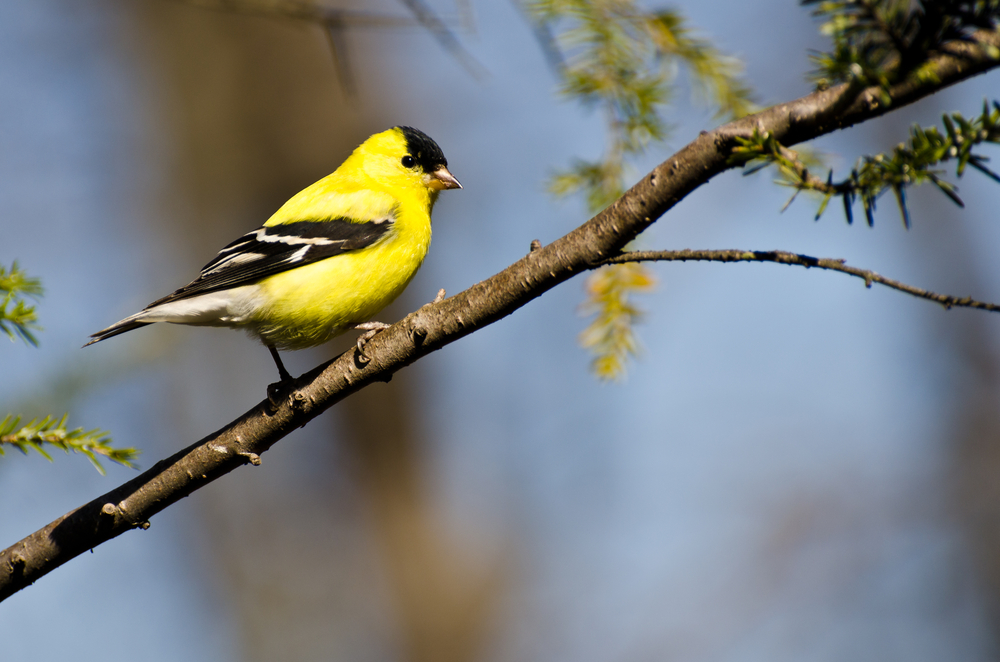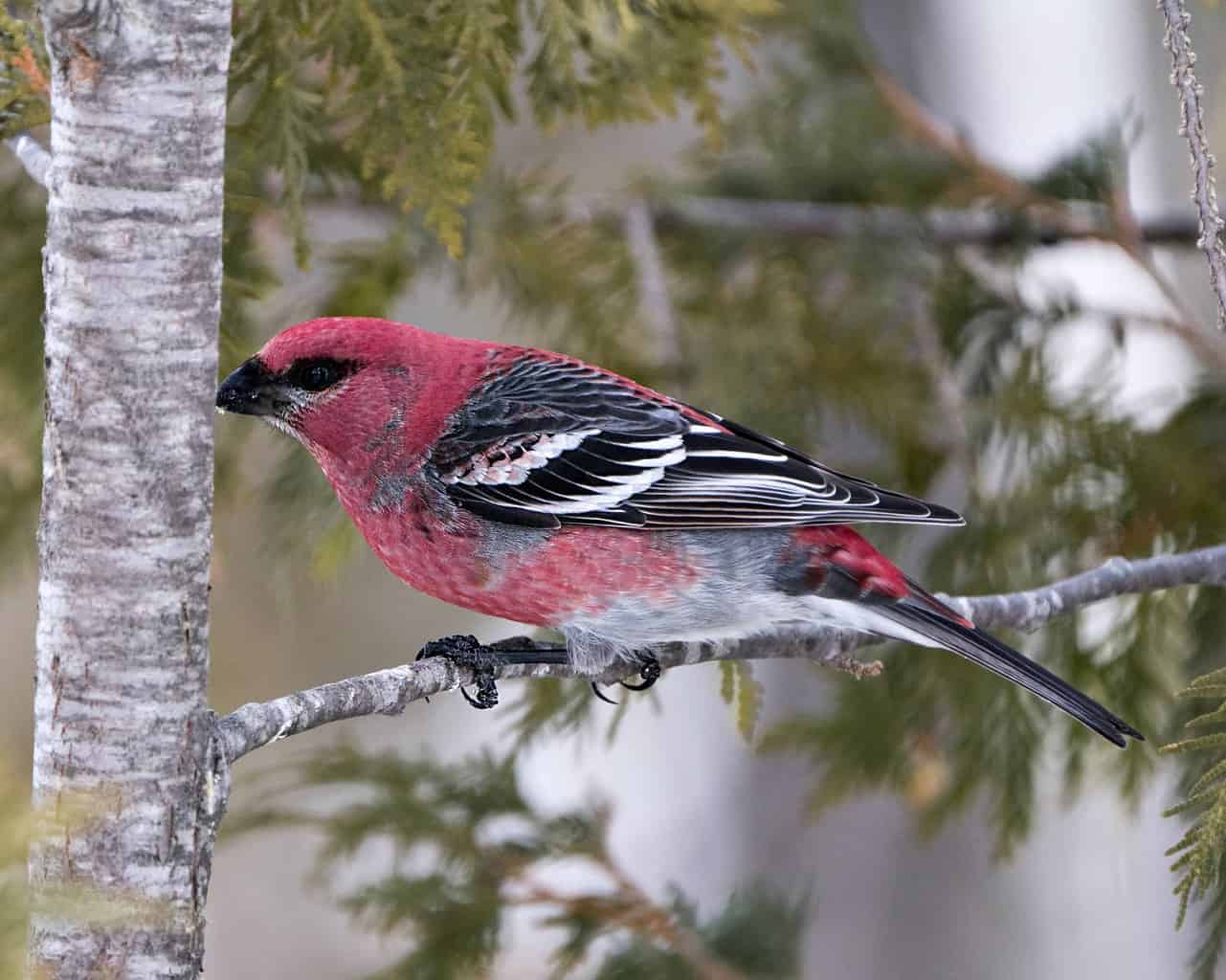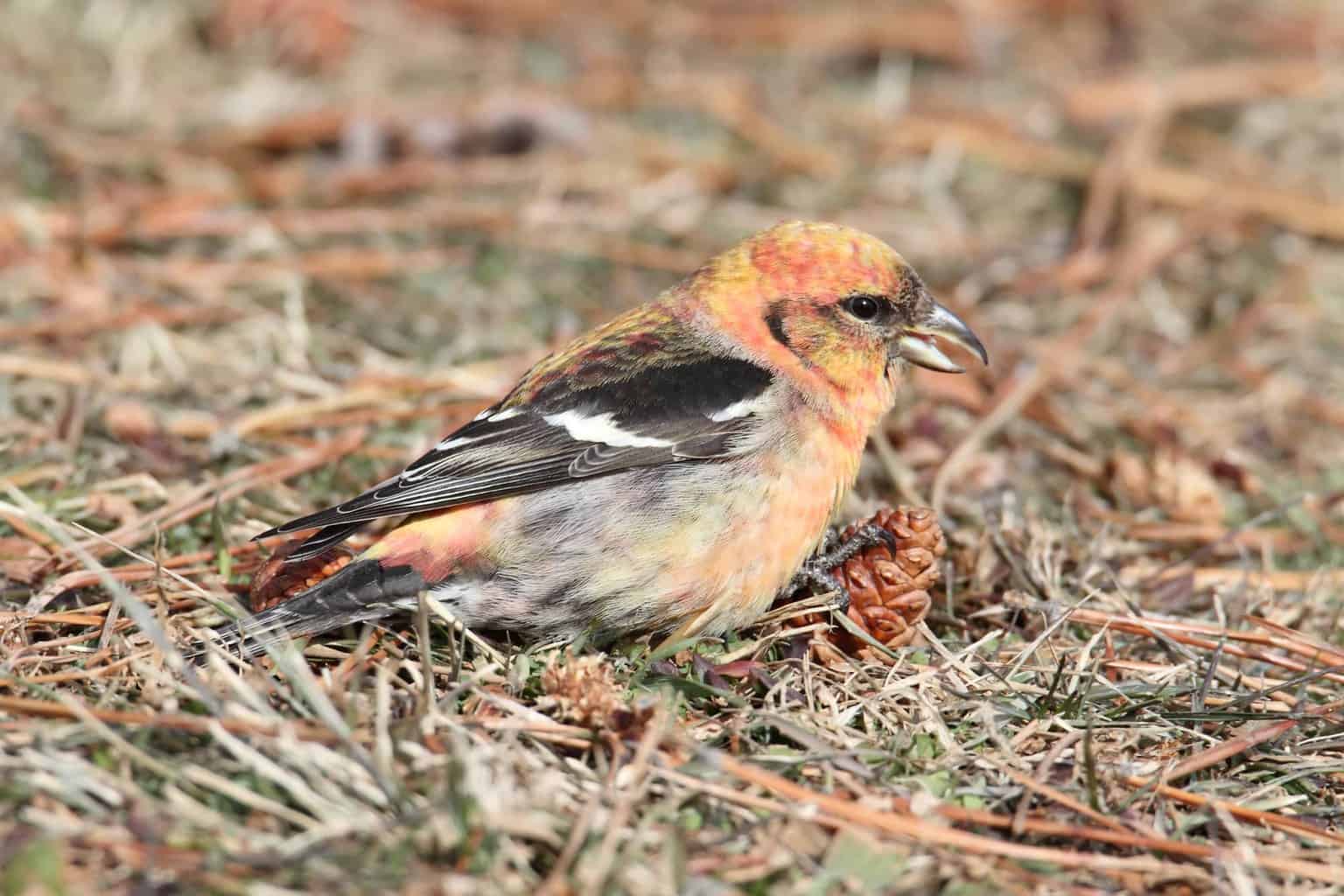From the energetic ruby-throated hummingbird to the majestic trumpeter swan, there is no shortage of avian wildlife for birdwatchers to admire in the First State.
Perhaps that should come as no surprise given birds’ impressive ability to adapt to just about any habitat (and the fact that this state which sits on the Atlantic Coast is not only level but well-watered thanks to an average annual precipitation of 45 inches and the presence of rivers such as the Nanticoke and streams such as Beaver Creek).
There are 427 bird species in the state of Delaware, 10 of which are finches. These colorful, gregarious birds are all covered here so you can find out just what sets them apart from all the rest.
Red Crossbill

- Scientific Name: Loxia curvirostra
- Length: 7.9 inches
- Weight: 2 ounces
- Wingspan: 12 inches
Rather large as far as finches go, this species is known for the russet coloring of its males. This coppery hue may be more widespread and pronounced in some birds compared to others, and may be blended with grayish-brown.
Females on the other hand, lack that characteristic coloring found in males with their plumage consisting of a blend of bronze at their upper and lower surfaces mixed in with grayish brown.
Both genders have a characteristic crossed beak which enables them to open pine and spruce cones with minimal effort. They also have dark wings edged with grey or white.
These birds prefer to live in coniferous forest where they feed on the seeds of firs, hemlocks, junipers, larches, pines, and spruces.
Red crossbills can be found throughout Delaware all year round although their numbers are by no means abundant. Their range extends throughout the United States and beyond to Mexico, in the south.
House Finch

- Scientific Name: Haemorhous mexicanus
- Length: 6 inches
- Weight: 0.6 – 0.9 ounces
- Wingspan: 10 inches
Talkative and gregarious, house finches are known for their habit of showing up at bird feeders in large groups.
Males can be recognized by a dash of rose pink at their crowns, throats, and breasts and light brown coloring marked with darker streaks.
Females come with the same streaked plumage as their male counterparts, but none of their pink pigment. Both genders have brown wings which pales towards the edges.
House finches can be found throughout Delaware all year round in parks, gardens, and backyards. Their range extends throughout the United States with the exception of Florida’s southern tip.
Purple Finch

- Scientific Name: Haemorhous purpureus
- Length: 4.7 – 6.3 inches
- Weight: 0.63 – 1.10 ounces
- Wingspan: 10 inches
Male purple finches are covered in plumage which is completely pink at the head and is a blend of white and pink at the chest, and pink and brown elsewhere. Females are generally brown with the exception of their chests which are pale and covered with brown stripes.
Purple finches can be found throughout the second smallest state in the USA. The species breeds in Canada where it also indulges in its preference for conifer seeds.
Its members prefer wooded areas and may also visit bird feeders too although they are less likely to do so than house finches.
American Goldfinch

- Scientific Name: Spinus tristis
- Length: 4.3 – 5.5 inches
- Weight: 0.4 – 0.7 ounces
- Wingspan: 7.5 – 9 inches
The breeding male American goldfinch can easily be recognized by its bright yellow plumage. This vibrant color occasionally shot through with dashes of white, covers its body in its entirety. The sole exceptions are its crown which is covered in black feathers, its wings which are mostly black, streaked with white, and its rump which is white.
Breeding females, however, are covered in a muted, dull yellow and have the same dark wings as their male counterparts. In winter American goldfinches swap their summer plumage for a more subdued olive brown and yellow.
This species is especially fond of milkweed and thistle, although its members will avail themselves of nyjer and sunflower seeds at birdfeeders as well. American goldfinches can be found throughout Delaware, all year long. Their range actually extends throughout the United States and as far north as Canada.
Lesser Goldfinch

- Scientific Name: Spinus psaltria
- Length: 3.5 – 4.7 inches
- Weight: 0.3 – 0.4 ounces
- Wingspan: 6 – 11 inches
At first glance, male lesser goldfinches might be mistaken for their larger relatives, American goldfinches, owing to their plumage with a similar golden coloring, wing pattern, and black cap.
However, closer scrutiny reveals the presence of a black or olive upper surface – those found in the eastern United States have a black upper surface. Females, on the other hand, are olive and brown with dashes of yellow.
This small finch is rather adaptable and can be spotted in pine forests as well as arid areas. The nimble avian is often found close to sources of water and is rather partial to sunflower and thistle seeds.
The lesser goldfinch is only rarely spotted in Delaware. This is due to the fact that its range is mostly confined to the western United States.
Evening Grosbeak

- Scientific Name: Hesperiphona vespertina
- Length: 6 – 9 inches
- Weight: 1.3 – 3.0 ounces
- Wingspan: 12 – 14 inches
Male evening grosbeaks have a uniquely patterned plumage which is brown at the head interrupted by a bold yellow connecting stripe above both eyes. This somber hue lightens to olive at the nape and throat, yellowish brown at the upper surface, and yellow at the undersurface.
The wings of these rather robust finches are white at the center, edged thickly with black. The plumage of both female and young males are both a delicate gray which lightens at the undersurface, with hints of yellow.
Evening grosbeaks seek out berries; maple syrup; ash, box elder, and maple seeds, as well as salt and gravel. They are also rather fond of sunflower seeds provided by feeders.
They mainly breed in Canada and parts of the western United States such as Idaho, Montana, Oregon, Wyoming, and Washington. However, their range extends throughout North America including Delaware in its entirety although they are not a frequent occurrence in the state.
Pine Grosbeak

- Scientific Name: Pinicola enucleator
- Length: 8 – 10 inches
- Weight: 2 – 3 ounces
- Wingspan: 13 inches
The distinguishing features of male birds belonging to this species include smooth pink plumage which is barred with black just below the nape, and contrasts with dark wing feathers edged with white.
The plumage of their female counterparts is generally gray although the head feathers of this gender are russet-colored.
These beautiful birds are known for their ability to tuck away impressive quantities of food (they are fond of conifer seeds, crab apples, and insects), for their habit of moving rather sedately while feeding, and their ability to tolerate close human proximity in comparison to most birds.
Although they are generally found in northern Alaska, Yukon, the Northwest Territories, and Quebec, pine grosbeaks can also be found further south. However, they are mainly found in the western and southwestern United States in Arizona, California, Colorado, Nevada, Oregon, and Washington and are rarely found in Delaware in the east.
Common Redpoll

- Scientific Name: Acanthis flammea
- Length: 4.5 – 5.5 inches
- Weight: 0.4 – 0.6 ounces
- Wingspan: 8 – 9 inches
Common redpolls exhibit a plumage which is dark red at the crown, with striations against a pale background, elsewhere. They also have dark wing feathers edged with white.
Males of the species also have a flush of pink at the chest while the striation on the plumage of females is more pronounced.
Common redpolls breed in the islands around the Arctic and as a result are impressively cold-tolerant. They are especially fond of birch seeds although they will also rely on conifers and willows for food.
These birds are capable of traversing great distances with a member of the species having been known to fly from Europe to East Asia.
Common redpolls generally live in Canada. Their southern range also includes Idaho, Montana, Washington, Wisconsin, and Wyoming. While it may extend as far south as Colorado, these birds are more commonly seen in the northern part of the United States and are rarely seen in Delaware, as a result.
Pine Siskin

- Scientific Name: Spinus pinus
- Length: 4.3 – 5.5 inches
- Weight: 0.4 – 0.6 ounces
- Wingspan: 7 – 9 inches
Pine siskins are covered in brown streaks which stand out against a pale background and come with wings which are edged with yellow and white.
These medium-sized finches tend to enjoy thistle and sunflower seeds. They also eat the fruit of alder, birch, and spruce.
Although pine siskins breed in Canada, they can be found in every state throughout the United States. As a result, they may be spotted in Delaware, but only rarely, and only during winter.
White-Winged Crossbill

- Scientific Name: Loxia leucoptera
- Length: 5.7 – 6.7 inches
- Weight: 0.9 – 1.40 ounces
- Wingspan: 11 inches
Male members of the species exhibit a red coloring on their plumage which contrasts with black wings marked boldly with white.
Their female counterparts lack that distinct vivid coloring and are instead grayish-brown with a touch of bronze at the throat, neck, and head.
The characteristic short dark crossed beak used to open pine cones, is also present in both genders. White-winged crossbills are also fond of feeding on larch and white spruce seeds.
This species prefers to remain in Canada all year long and can be found throughout the United States’ northern neighbor with the exception of its northernmost extremities.
Its range also extends as far south as New Mexico. However, white-winged crossbills may only rarely be seen in Delaware.
Conclusion
Delaware is home to ten species of finch with certain of them such as the American goldfinch and the purple finch being present in abundance with increased opportunities for sightings.
North America’s sixth most densely populated state is also home to species such as the evening and pine grosbeaks which do not occur as frequently. It may also be visited by common redpolls and pine siskins which are only very rarely seen.
Yet as previously noted, Delaware is home to over 400 bird species. Which means an abundance of opportunities for birdwatchers to view even more avian residents of the Blue Hen State as well as visitors.

